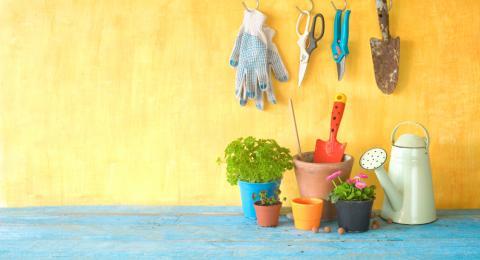
Like everything else in life, gardens and green spaces need to be de-cluttered to stay beautiful and not overload the soil. Here are a few pointers...
I love green spaces, and honestly, who doesn’t? Green is peaceful yet teeming with life, soothing yet all-important in supporting human life. The health benefits to gardening are undeniable, and it’s a de-stressor unlike any other for all ages. But sometimes, in our enthusiasm, we tend to go overboard with stuff and end up turning a garden into a jungle—wild, untamed, and very uncultured, so to speak.
While we’re not saying that this is necessarily bad, an overgrown garden is not really a thing of beauty because it becomes impossible to reap the benefits of that green space. After a point, overgrowth means the danger of bugs, thorns, and other whatchamacallits living in the soil when you try to reach for that luscious fruit or the beautiful flower. Plus, having too many plants in one area leaches the soil and ultimately slows growth for all.
So what is a gardener to do? Let’s count the steps to culling the clutter in the garden because green is good but too much of a good thing can be bad!
How To De-Clutter The Garden
When it comes to doing up a garden (and we do not mean a bare patch of land), it’s always the chicken or the egg story. What comes first? Should you raze it all and start again, or remove only the weeds, or start patch-by-patch? It’s more like what’s the first step because as cliché as it may sound, well begun is usually half done! So here are a few pointers…
1. Treat Unwanted Plants Like Weeds
Come spring, poppies sprout in my garden like nothing ever did—and they do it on their time, their space, and their code. Do they look pretty? Sure. Did I want them to pop up like bunnies everywhere? Nope. So there are two things to do here: if you really want to save the plants and be Mother Nature’s unrestricted ally, gather the saplings and transplant them to a flower bed, else the unwanted growth will basically make them act out like weeds and leach nutrients from other plants. If you don't want the plant, treat it like a weed.
2. Make Well-Defined Flower Beds
As beautiful as spring and summer flowers look, a well-defined garden will look stunning, while an overgrown one will only look uncared for. Flowers belong in flowerbeds, and you need to make proper space for them. Use garden separators like pots, bricks, and stones to create long and winding paths along driveways, along edges, and around trees. Snake it along the whole garden if you like but keep them limited within boundaries.
3. Keep The Kitchen Garden Separate
Vegetables, herbs, and produce are fun to grow—and there’s nothing like feasting on organic produce from your very own garden, right? However, plan the kitchen garden separate and away from your manicured lawns and flower beds—in fact, veggies are best left to the backyard where they can be kept safe from inquisitive noses, hands, and fingers! Also, you don’t want the bugs and insects that affect produce to get into your flowers or vice versa. It's just that the handiest part of your garden (i.e., the produce section) will not look as great and ornate as the beauteous part of the garden, the flower section.
4. Prune, Mercilessly
Once the blooming and growing season of a particular plant is over, you need to take out those pruning shears and get to work. All the branches that are growing in a teeming, tearing hurry in whichever direction they want need to be culled, as does anything dead or dying. In fact, if you want bushes and shrubs to look ornamental and lush, pruning is something you have to be at pretty regularly—else plants may not have a mind of their own, but they can certainly have growth spurts on their own.
5. When In Doubt, Plant Lawns
If you leave bare soil, weeds will sprout with great temerity, just about everywhere and everyhow. You can, of course, cover the soil with mulches, but every time you plow or upturn the soil, mulches will get mixed with soil. So another way to effectively cover bare patches of soil where you don’t want to plant anything is to put in a patch of lawn grass—it makes for great visuals, is a nice place to rejuvenate your tired soul, and also prevents soil erosion and nutrient leaching. Of course, grass can also help in rainwater harvesting by actually filtering out the pollutants from the water as it moves through the soil.
6. Hedges Make For Great Separators
Want to separate a few spaces in the garden? Maybe create a division within a flower bed? Or create a beautiful boundary around a tree? Think of hedges then—they create natural separators and boundaries in the garden. And you can get different kinds of hedges to add every kind of color from various shades of green, to red, or even purple. You can get hedges with only foliage or the kind that bloom in particular seasons; they all look stunning and work perfectly fine in creating a lovely landscape of green.
7. Stick To Pots For Seasonals:
Finally, seasonal flowers look beautiful. They come in the most enchanting hues and shades and make your garden look like heaven on earth. But like with all beauty, theirs is transient and lasts only the season they are supposed to bloom in. So what do you do with them? Instead of planting them in midst of the garden and then uprooting it all when the season dies, why don’t you use pots to plant your season's blooms in? This way, when the season changes and your beloved petunias and poppies die, you simply plant in the new season’s blooms instead with lesser work and fuss.
8. Visualize The Big Picture
Finally, the most important step that goes into creating a beautiful garden is visualization—look at the bigger picture and don’t keep buying plants without knowing what to do with them. It has to be a demand and supply basis: first let your garden demand something new, only then head out to the nursery to get what your green spaces need to truly thrive.








